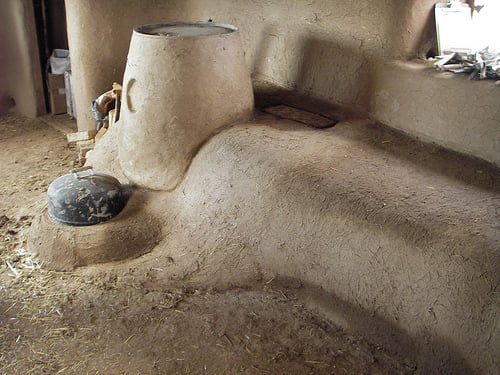
Thinking to build a rocket stove mass heater, but are very new to the idea? Follow along as we find out as much as we can about them. One Appropedian plans to eventually build one of his own (#Contact details). Any assistance would be greatly appreciated!
Advantages
- heat your home with much less wood than an open fire (it has been claimed 5 to 10 times less)
- exhaust is mainly steam and CO2, with much less of the impurities normally contained in smoke. (A little smoke is emitted at the beginning.)
- the heat from one fire can last for days thanks to the thermal mass
- you can build one in a day and half
- cost is very low - it is possible to build one for less than $20, plus natural materials collected locally (mainly earth).
Design principles
A stovepipe or chimney is still recommended to vent the air to the outside to minimize indoor air pollution. To gain as efficient a heat transfer as possible, use a long thin pipe or heat exchanger, to extract maximum energy from the flue gas. The challenge here is that increasing the resistance offered by the pipe will interfere with operation of the furnace. Increasing the height of the vent increases the chimney effect and may counteract this.
Questions
- It seems that when initially starting the fire, smoke might not draw through the system until the burning chamber is heated and drawing enough air so that smoke is taken out the exhaust. If this is a common problem, what additions could be added to the design so that smoke does not fill the room in which the heater is situated?
- Can the mass covered flu work vertically so that the hot gasses can be drawn downstairs and then exhausted back upstairs?
- How long does the stove top last given the amount of heat being put there? Is maintainence built into the standard design?
Understanding the market
- Permits and local regulations need to be considered which often require partical output measurements along with efficiency ratings. This will be difficult for a self built RSMH as it will always be different.
- RSMH are largely Do It Yourself and so are not commonly seen as sellable commodities and do not have standards in place.
- Fuel efficiency and possible reduction in emmissions could make this heater a prefered heating method in many regions
Next steps
Contact details
Leigh Blackall in Canberra, Australia is working on this and would like to hear from you: leighblackall
See also
Interwiki links
External links
- I Love Cob Rocket Mass project well documented
- rocket stove mass heater - richsoil.com article with explanation and instructions, including pictures and video.
- A photo gallery of an installation
- A Youtube playlist looking at various installations and design considerations
- Rocket Mass Heaters: Superefficient Woodstoves YOU Can Build (Paperback) by Ianto Evans and Leslie Jackson
- Rocket stove and butt warmer -thread at permies.com
- Clean Sustainable Wood Burning 2 videos and blog on Earth Day Rocket Mass Heater
- Podcast on Rocket Mass Heaters by Paul Wheaton, and Ernie and Erica Wisner